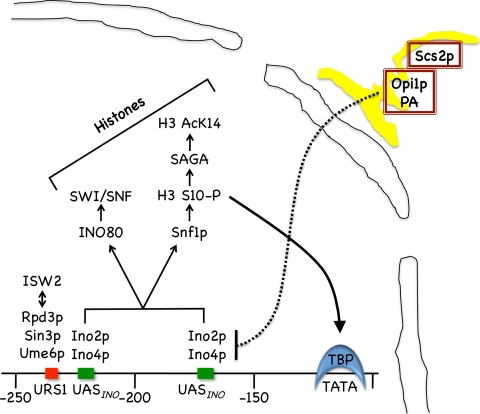Fig. 1.
Model for regulation of INO1 transcription. Shown is a schematic of the INO1 promoter containing two UASINO elements (shown in green) and a repressor site (URS1) (shown in red). Under derepressing conditions (I− C−), the Ino2p-Ino4p heterodimer binds to two UASINO elements and recruits INO80 and Snf1p. INO80 is a chromatin-remodeling complex that recruits another remodeling complex, SWI/SNF. Snf1p is a kinase that phosphorylates serine 10 (S10) on histone H3, which in turn recruits SAGA, which acetylates lysine 14 of histone H3. Histone 3 S10-P promotes the interaction of the TATA-binding protein (TBP) with the INO1 TATA sequence. Under derepressing conditions, the Opi1p repressor is complexed with phosphatidic acid (PA) and retained in the endoplasmic reticulum (ER) (shown in yellow) by association with Scs2p. Under repressing conditions (I+ C+), PA levels drop, and Opi1p is released from the ER, translocates to the nucleus, and associates with Ino2p, repressing transcription. URS1 is a binding site for the general repressor Ume6p, which recruits the Sin3p corepressor and the Rpd3p histone deacetylase (HDAC) complex.

